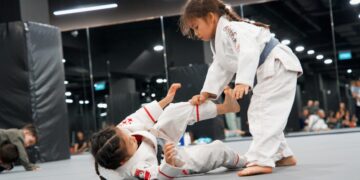
The back mount is the most dominant position in grappling sports such as BJJ. It allows you to submit your opponents or rain down strikes in an MMA match while keeping them second-guessing. Getting there is one thing, but keeping it is another. Today, we will discuss four practical ways to maintain back control.
What Is Back Control?
Under the IBJJF rulebook, back control is when a grappler takes control of the opponent’s back by placing their heels between the opponent’s thighs without crossing the legs, putting them in a position to trap at least one of the opponent’s arms without trapping it above the shoulder line. While similar to the back mount, which is a common term used when a grappler is behind their opponent, the IBJJF definition of back mount is when a grappler is behind the opponent and sits on the opponent’s torso, with both their knees or one foot and one knee on the mat, while facing the opponent’s head with up to one arm trapped under the leg.
An advantage of having back control is that it allows you to control one or both arms of the opponent while controlling them from behind, allowing you to hunt for chokes or go for ground and pound in MMA. Relatively, an athlete can have back control but not be in the back mount, but if an athlete has the back mount, they essentially have back control.
4 Ways For Effective Back Control
As mentioned earlier, finding the path to back control and getting there is already a skill, but being able to keep the position is another skill set. Below are four ways to effectively control your opponents from behind.
Diagonal Control
The concept of diagonal control gives you complete control over the opponent’s body, starting from one hip to the opposite shoulder. This means that if you have control over the opponent’s right hip with a hook, you must control their left arm in some way. While having diagonal control from behind, if the opponent moves away, you don’t control their entire body at both their shoulder and hip, but you control their whole body diagonally from one side to the other.
You can do this by using the cross-body ride or inserting one hook (opponent’s right hip) and controlling their far wrist (left wrist), controlling their body from one shoulder diagonally across to the opposite hip. If you have one hook without diagonal control (control of the opponent’s far wrist), the opponent can always face you and re-guard, making it difficult for you to follow the opponent. Now, assuming you already have this control, it is difficult for the opponent to roll on their left shoulder as you are controlling their arm. If they can roll on their right shoulder, which is difficult, you can always follow their body as they roll.
You can also use this concept in MMA. You can strike with your free hand (right hand) while your other hand (left hand) controls the opponent’s far hand. You can base your other leg (left leg) on the mat or lock it with your right leg.
Chest-To-Back Connection
Applying effective back control typically involves using the seatbelt, some type of hook, or pulling your opponent to your dominant side (overhooking arm side). Having said this, securing a chest-to-back connection is one of the most important things to maintain control over your opponent. While the conventional way of controlling the back is with two hooks, it doesn’t mean that both are required to make your back control effective; you can have no hooks in and choke the opponent just as fine if you know what you’re doing.
Many grapplers are so focused on applying the hooks that they forget the premise of the back, which is having your chest against the opponent’s back. Keeping chest-to-back connection with your chin locked beside the opponent’s head for security will give you excellent back control because when the opponent scrambles to escape, you can always get up on your knees and stand up as you sit up the opponent and step over the same side as your seatbelt (overhooking arm) as you fall to the same side to retain the back.
Dagestani Handcuff
The Dagestani handcuff uses the same principle of diagonal control. It requires you to control one side of the opponent’s hip as you control their far arm using one hand or a two-on-one grip. With this wrestling principle added in the BJJ context, the Dagestani handcuff is an excellent skill to add to your arsenal, especially for MMA. This technique lets you control the opponent from behind or switch to the full mount.
Usually, if you apply the Dagestani handcuff from the top position, you have several options, like striking your opponent with your free hand. When they manage to face you, you can either take their back or go for an arm triangle choke.
Threat Of A Choke
When defending a choke, both arms are expected to be used to maximize the chances of escaping. For illustration purposes, let’s use the terms primary and secondary hand to define the arms of the defender. The primary hand is the opposite of your strangle arm (overhooking arm), and the secondary is used to assist in recovering the hand or fighting your feet.
If you can’t clear the opponent’s primary hand from controlling your strangle arm, you won’t be able to get your hand up to their neck for a choke. Generally, your goal is to take the strangle hand across the opponent’s shoulder, and their goal is to take it down to the same side.
The lower to the same side your strangling hand is, the better it is for the opponent. The higher and the farther your strangling arm is to the opponent’s opposite shoulder, the better it is for you. Remember that whoever’s hands are on top wins the hand fight. If you have your hands on top of the opponent’s hands, you can control the hand fight, and if the opponent can control your primary hand (strangle hand), they can win the exchanges.
If you can keep a constant threat of choking on the opponent’s neck, you will have a higher success rate in keeping back control and finishing the opponent from behind. The reason is that if the opponent constantly thinks of the threat of a choke, they can’t focus on escaping as they can only think of defending one thing at once. The opponent can be thinking about escaping by misaligning their body to yours (making it difficult for you to strangle them as you will have to recover the control), or the opponent has to be focused on the submission by protecting their neck.
When applied in MMA, having good control of the opponent’s back with a submission threat will open them up to strikes, and striking the opponent from behind will open them up to submissions.
Conclusion
Becoming proficient with back control requires practice and countless rounds of positional sparring. If getting behind the opponent is part of your game, practice the different controls we discussed in this article to see which works best for your personal game. Remember that predicting the opponent’s movements with a constant threat of strikes or submissions is oftentimes the best approach. Use it to your advantage to successfully set up your attacks.
You may also like:
Brazilian Jiu-Jitsu And Law Enforcement: Training Officers In Ground Control And Self-Defense
A growing number of law enforcement agencies worldwide are making Brazilian Jiu-Jitsu a mandatory part of their training, pointing out that the popular grappling-based martial arts leads to fewer injuries for both officers and the…
The back mount is highly regarded as the most dominant position in BJJ. Getting there is already a challenge, and maintaining it is another. There are various ways to control the back mount, such as…
The toe hold is one of the most popular leg attacks in Brazilian Jiu-Jitsu. It is a move that is typically seen in colored belt matches and is an unexpected technique that can end a…
You’ve seen it on television, featured in mixed martial arts events, or completely on its own. Brazilian Jiu-Jitsu (BJJ) is one of the most popular sports on the planet, and subsequently, one of the most…
Mental health issues have become more prevalent in the past few decades, and they often have multiple consequences on the lives of the afflicted. These disorders can significantly impact a person’s ability to be an…
In grappling sports like Brazilian Jiu-Jitsu, wrestling, and MMA, mastering various takedowns can provide a significant advantage. One fundamental aspect of establishing control in these sports is securing an underhook. An underhook is a controlling…
Boxing remains one of the most popular combat sports worldwide thanks to the memorable battles that take place inside the squared circle. Amidst the hypnotizing footwork, mesmerizing head movement, and tactical defense boxers often showcase,…
You’ve probably heard the expression “fight IQ” often when watching combat sports like mixed martial arts. The term refers to a fighter’s ability to make the right decisions consistently during the heat of battle. This…
In Muay Thai, a round is broken down into dozens of small exchanges and, unless a knockdown takes place, the winner of a round, and inevitably the fight, comes down to who wins the most…
Boxing is one of the most globalized combat sports, and the top boxers remain some of the highest-paid athletes in the world. Anyone can master the sweet science and enjoy the many rewards that come…
Have you considered learning self-defense skills at a martial arts gym in Singapore or exploring an unknown part of the city on the weekend? These healthy recreational activities can help you to unwind and destress,…
In boxing, the brawler boxing style is often used to refer to boxers with a limited understanding of the fundamentals of the sweet science. It is an aggressive fighting style that prioritizes attacking over defending…


































